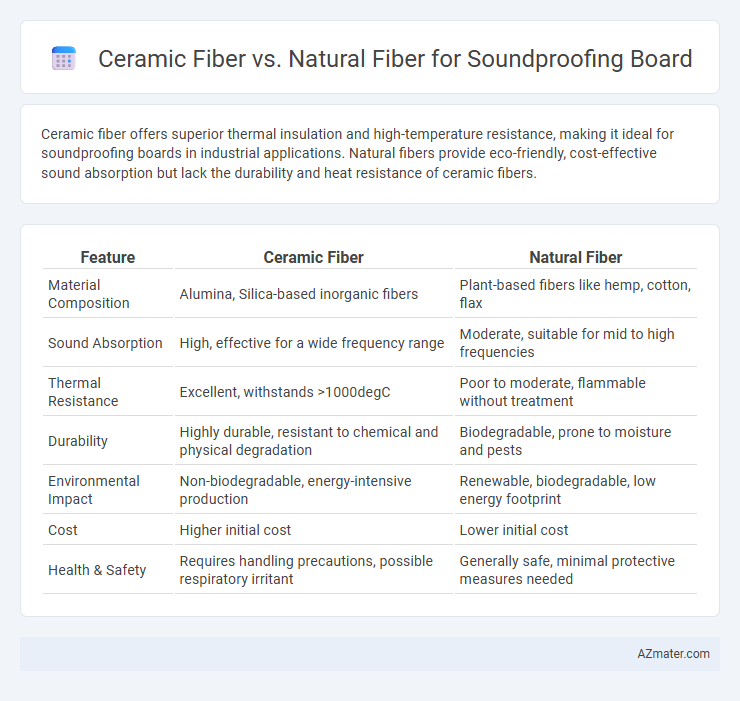Ceramic fiber offers superior thermal insulation and high-temperature resistance, making it ideal for soundproofing boards in industrial applications. Natural fibers provide eco-friendly, cost-effective sound absorption but lack the durability and heat resistance of ceramic fibers.
Table of Comparison
| Feature | Ceramic Fiber | Natural Fiber |
|---|---|---|
| Material Composition | Alumina, Silica-based inorganic fibers | Plant-based fibers like hemp, cotton, flax |
| Sound Absorption | High, effective for a wide frequency range | Moderate, suitable for mid to high frequencies |
| Thermal Resistance | Excellent, withstands >1000degC | Poor to moderate, flammable without treatment |
| Durability | Highly durable, resistant to chemical and physical degradation | Biodegradable, prone to moisture and pests |
| Environmental Impact | Non-biodegradable, energy-intensive production | Renewable, biodegradable, low energy footprint |
| Cost | Higher initial cost | Lower initial cost |
| Health & Safety | Requires handling precautions, possible respiratory irritant | Generally safe, minimal protective measures needed |
Introduction to Soundproofing Boards
Soundproofing boards utilize various materials to reduce noise transmission, with ceramic fiber and natural fiber being common options. Ceramic fiber offers high thermal resistance and excellent sound absorption due to its porous structure, making it ideal for industrial and high-temperature applications. Natural fiber boards, often made from materials like hemp or cotton, provide sustainable and eco-friendly soundproofing solutions with effective acoustic insulation properties in residential and commercial settings.
What Are Ceramic Fibers?
Ceramic fibers are inorganic, non-metallic fibers composed primarily of alumina and silica, known for their high-temperature resistance and excellent sound absorption properties. These fibers create dense, porous structures ideal for soundproofing boards, effectively reducing noise by trapping and dissipating sound waves. Compared to natural fibers like hemp or cotton, ceramic fibers offer superior durability, thermal stability, and fire resistance, making them a preferred choice in industrial and commercial acoustic insulation applications.
What Are Natural Fibers?
Natural fibers, derived from plants, animals, or minerals, include materials such as cotton, wool, hemp, and flax, commonly used for soundproofing boards due to their eco-friendly properties and natural acoustic absorption. Unlike ceramic fibers, which are synthetic and heat-resistant, natural fibers provide good insulation by trapping air within their fibrous structure, enhancing sound dampening. Their biodegradability and low environmental impact make natural fiber soundproofing boards a sustainable alternative for noise control in residential and commercial applications.
Acoustic Properties: Ceramic vs Natural Fibers
Ceramic fibers exhibit superior acoustic absorption due to their high density and porous structure, effectively dampening mid to high-frequency sound waves compared to natural fibers like hemp or cotton. Natural fibers provide moderate sound insulation with better performance in low to mid-frequency ranges but often require thicker layers to achieve similar noise reduction levels as ceramic fiber boards. The thermal stability and fire resistance of ceramic fibers further enhance their acoustic durability in environments exposed to heat or moisture.
Thermal Insulation Comparison
Ceramic fiber offers superior thermal insulation compared to natural fibers, with a low thermal conductivity typically around 0.05 W/m*K, making it highly effective at reducing heat transfer in soundproofing boards. Natural fibers like cotton, hemp, or wool have higher thermal conductivity values, generally ranging from 0.04 to 0.07 W/m*K, but their thermal performance can be less consistent due to moisture absorption and organic degradation. The durability and fire resistance of ceramic fiber further enhance its thermal insulation stability, positioning it as a preferred choice for high-temperature or industrial soundproofing applications.
Durability and Longevity Analysis
Ceramic fiber soundproofing boards exhibit superior durability due to their high resistance to heat, moisture, and chemical degradation, ensuring long-term structural integrity in various environments. In contrast, natural fiber boards tend to absorb moisture, leading to potential mold growth and reduced lifespan under prolonged exposure to humidity. The inorganic composition of ceramic fibers allows for consistent performance and minimal maintenance over time, making them a more reliable choice for durable soundproofing applications.
Environmental Impact and Sustainability
Ceramic fiber for soundproofing boards is non-biodegradable and involves high energy consumption during production, leading to a larger carbon footprint compared to natural fibers. Natural fibers, such as hemp or cotton, are renewable, biodegradable, and typically require less energy to process, reducing environmental impact significantly. Using natural fiber soundproofing enhances sustainability by supporting circular economies and minimizing landfill waste.
Health and Safety Considerations
Ceramic fiber soundproofing boards offer superior heat resistance but pose respiratory health risks due to airborne fibers that may cause irritation or long-term lung issues if inhaled without proper protective equipment. Natural fiber boards, such as those made from cotton, hemp, or sheep wool, provide a safer alternative with lower toxicity and less airborne particulate matter, reducing health hazards during installation and handling. Proper ventilation and use of masks or respirators are essential for both materials to ensure safe indoor air quality and worker protection.
Cost and Installation Factors
Ceramic fiber soundproofing boards typically cost more than natural fiber options due to advanced heat resistance and durability, making them a premium choice for industrial applications. Installation of ceramic fiber boards requires specialized handling and protective gear because of their microscopic fiber particles, adding to labor intensity and safety measures. Conversely, natural fiber boards offer a more affordable price point and easier installation with standard safety precautions, making them suitable for residential or light commercial soundproofing projects.
Conclusion: Choosing the Right Fiber for Soundproofing
Ceramic fiber offers superior thermal resistance and high-temperature durability, making it ideal for industrial soundproofing applications where heat insulation is critical. Natural fibers, such as cotton or hemp, provide eco-friendly, cost-effective solutions with excellent acoustic absorption and sustainability benefits for residential or commercial soundproofing. Selecting the right fiber depends on balancing thermal requirements, environmental impact, budget constraints, and the specific acoustic performance needed for the soundproofing board.

Infographic: Ceramic fiber vs Natural fiber for Soundproofing board
 azmater.com
azmater.com